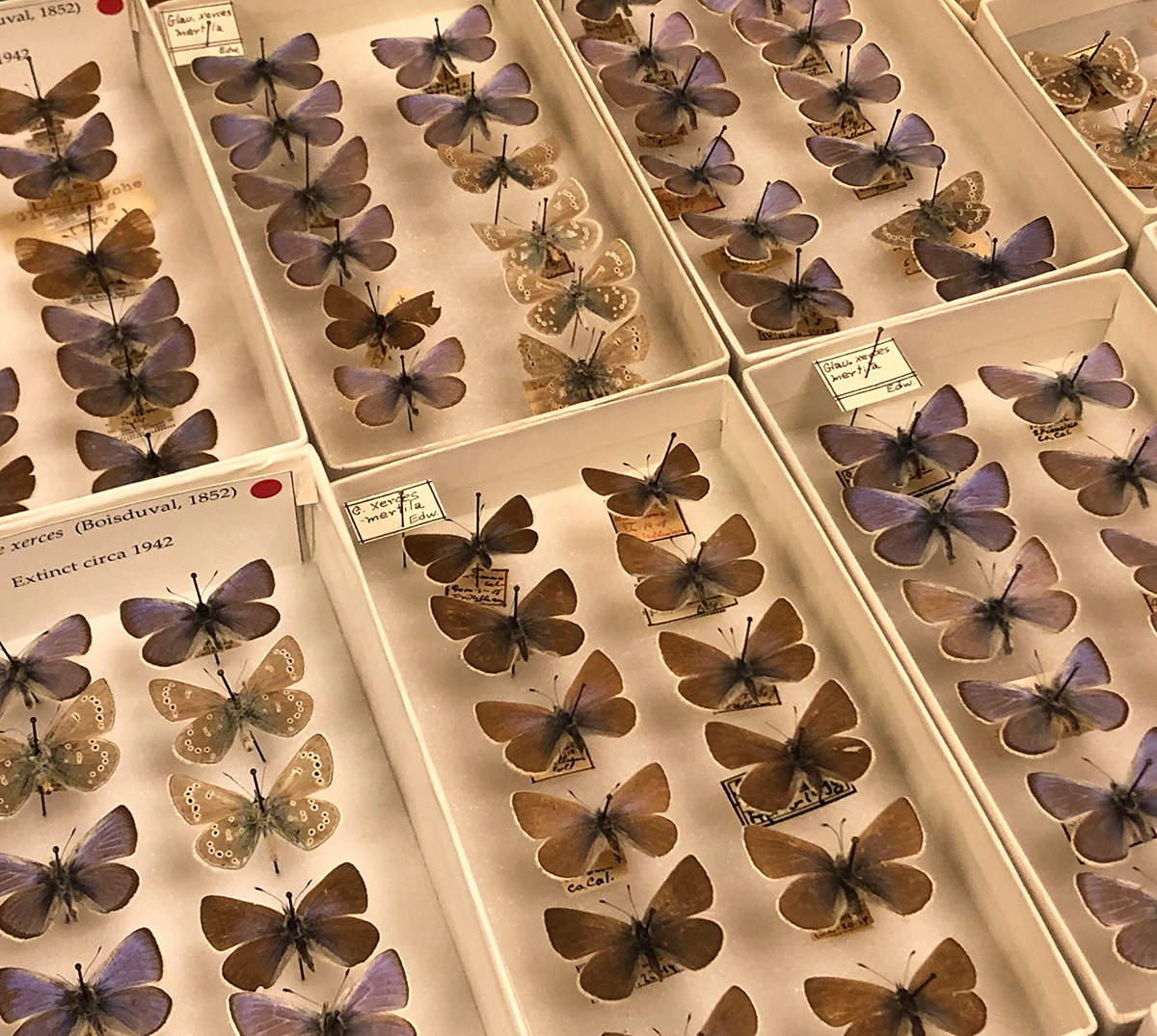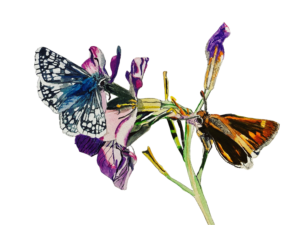
Read more about writer/illustrator Liam O’Brien and his butterfly conservation and education work in the Spring 2019 issue of Bay Nature. Subscribe today!
I attended my first National Lepidopterists’ Society meeting in 2001. It was held at Oregon State University in Corvallis. Checked in, got my welcoming packet and peeled off my name tag: “Liam O’Brien, San Francisco County.” Started to mingle. Very intimidating. Lots of older PhDs who all seemed to know one another. I stood on the edge of the room like I was at bad junior high school dance, waiting for someone to ask me to dance. Sipped my vinegary, white wine from a plastic cup. Knew absolutely no one.
“Oh, San Francisco?” a guy said.
“Yes,” I replied, “Have you been?”
“No, no, but my wife has always wanted to go.” I learned quickly that “the wife card” is played virtually in seconds whenever any male is “mingling” with a dude from San Francisco. Hmmm…
“Pretty famous place for butterflies,” he continued.
“Yes.”
As he merged back into the sea of the AARP crowd, he said, “Too bad about Xerces.”
“Yes,” I responded, virtually to myself.
A wife later cornered me and went on and on about how much fun it was to eat chowder out of a bread bowl down at Fisherman’s Wharf. “It’s a bowl … made of bread!”
Her husband stepped up and pointed at my name tag. “Hey, isn’t that where the extinct butterfly is from? What’s it called?”
“Xerces. The Xerces Blue.”
“Right. Saw a bunch of them in a university collection back east. Wouldn’t that be great if it was still alive.”
In the early years of my passion one truth became clear – San Francisco is more famous for what no longer flies here than for what still flies. The Xerces blue, Glaucopsyche xerces, became the first butterfly species removed from the planet Earth (at least we know of) because of our species — a constant pall over any San Francisco lepidopterist.

It all started with a Frenchman, Pierre Lorquin, who came to find gold in them-thar-hills of California during the 1840s famed rush. He never found gold but, lucky for us, he brought his butterfly net. He collected approximately 13 new-to-science butterflies from the sandy barrens of San Francisco: orange sulfur, Mylitta’s crescent, green hairstreaks, etc. He shipped them (or brought them himself — little record exists of his travels) back to his friend Jean Alphonse Boisduval from the Museo de Paris.
Boisduval, a naturalist and a physician, described one of these 13 in 1852 and named it after the Persian king who fought the Spartans at Thermopylae. Xerces is the French spelling of Xerxes (which led to many headaches for this researcher…) The color of the topside of the male matches the clear, California sky. The female: a slate-brown rust from above. The boy has a Jackson Pollock splattering of white polka dots below while the girl has what is more like the underside of its closest living relative — the Silvery Blue (Glaucopysche lygdamus) –– an array of black dots with white circles. Xerces came in an insane amount of variations, riffing off these four wing variations. These catalogued differences are most present in collections.
Collecting was huge in the Victorian Era and considered a female hobby. Many folks throughout the nation had the polka-dotted butterfly from San Francisco on their wish list. The expansion of post-Gold Rush San Francisco across the sand dunes to the West destroyed all but a few continuous habitats for the butterfly. Its plant hosts — the plants she needs to lay her eggs on – yellow bush lupine (Lupinus arboreus) and deerweed (Acmispon glaber), became more imperiled. Radical changes to the western side of the peninsula due to all the horses and livestock grazing on all the vast tracts of native plants became the norm.
Know from colonies within the sand dunes, the butterfly flew from Twin Peaks to North Beach and from the Presidio south to Lake Merced. It had one flight (“univoltine”) from March through April. The butterfly evolved with the cold, summer fog drifting constantly over the peninsula from the Pacific, seemingly unable to spread to the warmer places to the south and east.
When San Francisco lepidopterist Herman Behr wrote a letter to his friend Herman Strecker in 1875, his words would be quoted in any article on Xerces for decades to come: “G. xerces is now extinct to the downtown San Franciscan neighborhoods. The locality where it used to be found is converted into building lots and between German chickens and Irish hogs — no insect can exist.” But the famous lepidopterists at this time were more concerned their favorite collecting spots were evaporating, and never really made the connection that human activity might be one of the causes.
Not until F.X. Williams in 1910 wrote an article for the Entomological Society News on “The Butterflies of San Francisco”was that connection made:
Although butterfly collectors have taken sizable numbers of specimens of this species for many of the years it was around, it would no doubt be still alive today if sufficient natural habitat had been left undisturbed. It’s hard for many to imagine saving a piece of land solely for the benefit of one, rare butterfly, but it’s worth noting that these localized San Franciscan species were an indicator that truly unique habitats were gone forever.
By 1919, Xerces was restricted primarily to a single locality near Lobos Creek and its surrounding dunes within the Presidio boundaries. It might have been the tipping point.
But then I found a fascinating chapter while researching this piece — a guy by the name of R.G. Wind, a collector in the 1930s, tried unsuccessfully to relocate some to “more suitable sites.” Wow! Considering butterfly relocation is a small part of what I do today, this small baby step into “invertebrate restoration” was seminal. Yes, he failed. But … he tried.
I always say in my talks I just to want to be a part of people who try. I couldn’t find anything more on Wind, but will continue to look.
Multiple factors played into Xerces’s demise: habitat destruction, zealot collecting, even the introduction of the nonnative Argentine ant (Linepithema humile) that no doubt displaced many of the native ant species that tended the Xerces larvae on the host plants: the larvae are protected by the other predators and the ants receive a sweet, nectar substance from the back of the caterpillars. This is a unique behavior called “tending.”
On March 23, 1943, Dr. Harry Lange (who the Lange’s Metalmark, an endangered butterfly out at the Antioch Dunes, is named for) collected the last few Xerces on the wing. When a reporter brought him back out to the site near the old Military Hospital in the Presidio years later, he alluded to this shadow over him and that, at the age of 86, he hated being known for this deed: “I could have never imagined they’d be the last seen alive.”
When I surveyed all the Butterflies of San Francisco in 2007, I came across a sympatric species (those occurring in the same location) of Xerces that, thankfully, still flew in San Francisco to this present day: the “Coastal” Green Hairstreak” (Callophrys viridis ) in particular inhabits the same rocky outcrops in isolated parts of the city, much like Xerces did towards its end.

The difference this time, 60 years later, is there is a slew of folks trying to help the hairstreak from blinking out. The Green Hairstreak Project was an idea I brought to Nature in the City back then and its premise seems as easy today as it was then: flood the neighborhood with her host, coastal buckwheat (Erigonum latifolium), between its last strongholds in the Upper Sunset, giving the girls something to lay their eggs on as they dart about the streets.
I certainly don’t hold the Victorians nor the Edwardians accountable for Xerces disappearance. It was another time that truly pre-dated the idea of conservation. I, for one, am glad we still have the ability to see Xerces in drawers at museum collections throughout the country. It was a beautiful creature. But what San Franciscans are doing now to protect one’s experience to see Mission blues, variable checkerspots, monarchs and pipevine swallowtails transcends the shadow of Xerces forever.
Now, when they see my name tag at national meetings, they say: “Oh, San Francisco? I hear you are doing wonderful things out there.”
Yes. We are … trying.




